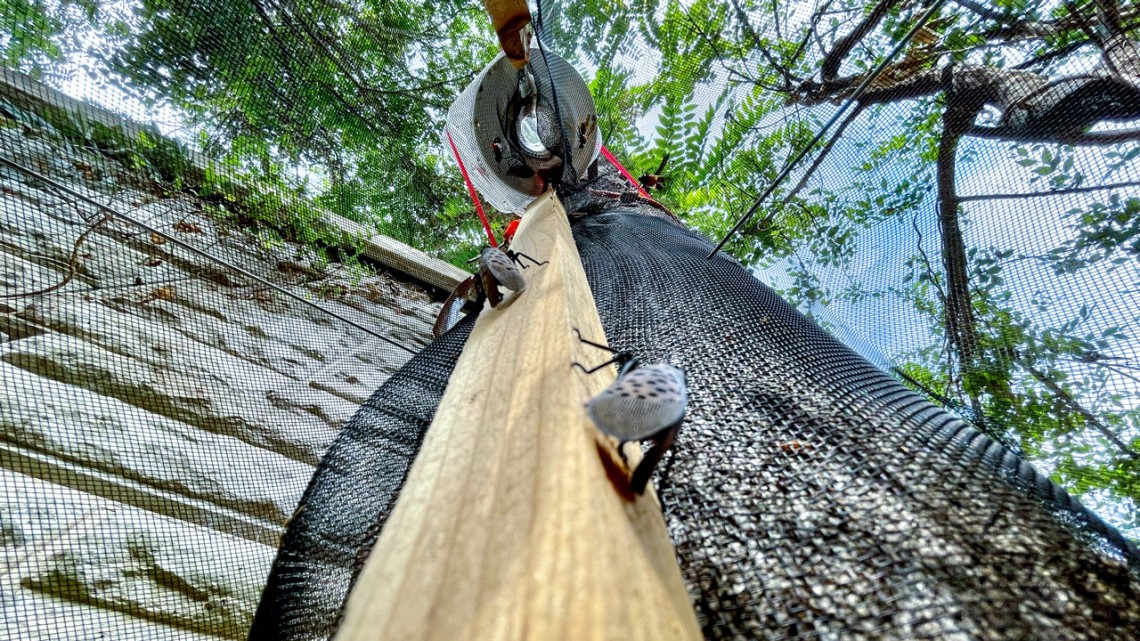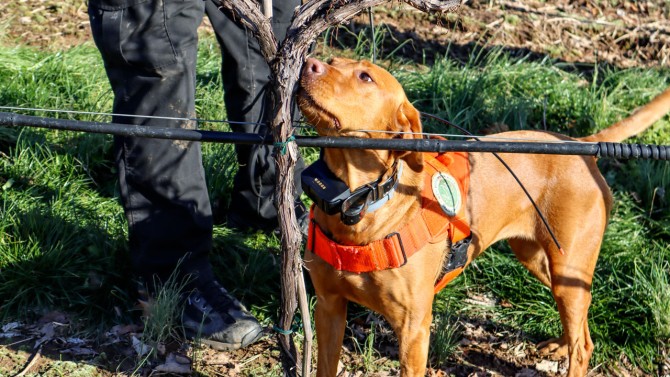
Cornell Cooperative Extension and New York State Integrated Pest Management are setting and monitoring traps at high traffic areas where the spotted lanternflies are most likely to appear.
Cornell partners with NYS to fight the spotted lanternfly
By Caitlin Hayes, Cornell Chronicle
The devastating spotted lanternfly’s spread to upstate and western New York is not a matter of if, but when, experts say – and Cornell is a key player in helping slow the infestation.
From providing farm workers with training in Spanish, to developing predictive modeling tools, to exploring whether dogs can detect spotted lanternfly egg masses, Cornell researchers and extension staff are working closely with New York state agencies to keep the pest at bay.
“This is the critical year for us in New York,” said Alejandro Calixto, director of the New York State Integrated Pest Management (NYSIPM) in the College of Agriculture and Life Sciences. “The ultimate goal is to reduce the speed of the spread, which will allow us to get more tools in place to manage it once it gets here, and to reduce the risk to people and agricultural systems.”
The spotted lanternfly, a destructive invasive species that has decimated vineyards in southeast Pennsylvania, is a particular threat to the Finger Lakes and western parts of the state, where the majority of New York’s grapes are grown.
NYSIPM, the Cornell Cooperative Extension (CCE), and the New York Invasive Species Research Institute (NYISRI) as well as individual researchers – through close collaboration with the New York State Department of Agriculture and Markets and the Department of Environmental Conservation, as well as the eight Partnerships for Regional Invasive Species Management (PRISMs) – have helped with surveillance, early detection and eradication, outreach and research.
The pests were first detected in Pennsylvania in 2014 and have since spread to 11 states in the eastern U.S. They’ve already been found in New York – with widespread populations in all five boroughs of New York City, scattered individual populations in the Hudson Valley, and small isolated populations in Ithaca and Binghamton. In heavily infested areas of Pennsylvania, in addition to being a nuisance – with swarms so large, it’s hard to be outside – they are a threat to numerous crops, including apples and hops, but have proven particularly devastating to the grape and wine industry, the area of biggest concern in New York.
The adult lanternflies are beginning to appear now – the instars mature and grow wings in July and August, becoming easier to spot and more mobile. They’re known to hitchhike and can lay their eggs on any surface, including the underbellies of cars and trucks, or the goods those vehicles transport.
“Cornell has all these tentacles, these relationships,” said Hans Walter-Peterson, senior extension associate and team leader of the Finger Lakes Grape Program. “We work with Ag and Markets and the PRISMS, and we have our regional teams. Then we sit in offices with 4-H people, with natural resources people, and county agriculture educators, who all deal with different aspects of life in New York state. We sit in the middle. Being able to take this science that we’re getting from different channels and share it in all directions, with all these other groups, is the only way we can do this.”
A seat in the middle
The Department of Agriculture and Markets is leading the state’s response to the spotted lanternfly threat, but Cornell provides key infrastructure for reaching growers.
NYSIPM and CCE work together to provide information to growers through CCE’s weekly growers’ meetings, both in-person and online, including providing kits for identifying the lanternflies at their different life stages and the insect’s favorite host, the invasive tree of heaven. They let growers know how they can report a lanternfly sighting and – looking ahead – what pesticides and measures for management have been approved and recommended.
Calixto has been providing trainings in Spanish for farm workers, who can make a huge difference early on in the season, when the grapevines are pruned. “Right now, early detection is key,” he said. “The egg masses overwinter, and if farm workers, a large majority of whom are Spanish-speaking, are able to detect those and remove them, you can significantly reduce the pressure in those vineyards.”
Brian Eshenaur, senior extension associate for invasive species with NYSIPM and a lead on the spotted lanternfly outreach, maintains the nationwide map for where lanternflies have been spotted and established. NYSIPM’s Dan Olmstead has developed a modeling tool, used by the Department of Agriculture and Markets in their monitoring, to predict what stage of the lifecycle to expect in a given location. In the Hudson Valley, Krystal Dixon, a CCE summer student intern, has been documenting her work setting up traps and learning more about the biology of the insects; CCE’s Finger Lake and Lake Erie Grape Programs are also monitoring traps at high traffic areas where the lanternflies are most likely to appear.
“There’s a lot going on,” said Jennifer Phillip Russo, extension associate and viticulture specialist for CCE and the team leader for the Lake Erie Grape Program, which covers 32,000 acres of grapes in western New York and Pennsylvania. Russo is working to develop a short video which the team hopes to put on local television and push out through social media. “The general population can be really helpful,” she said. “The lanternflies can build up in the woods before descending on crops, so we want to reach folks who are not growers, too.”
Providing the science
Back on the Ithaca campus, faculty are working on the spotted lanternfly problem as well.
Ann Hajek, professor of entomology in CALS, has made more trips to southeast Pennsylvania than she can count and has a colony of spotted lanternflies at a quarantine facility on campus.
“I’ve worked with fungal pathogens of insects for a long time,” Hajek said. “I was aware that they were good at infecting leaf and plant hoppers like the spotted lanternfly, and when I heard about it being here with such big populations, a light bulb went off.”
Hajek’s hunch was a good one. On a research trip in 2018, she arrived at a vineyard in Pennsylvania to find all of the lanternflies dead. They’d been killed by two native fungal pathogens, one of which, B. bassiana, was already commercially available in a number of biopesticides.
She and collaborators from Pennsylvania State University immediately ran a field trial to confirm and quantify the observations, and her postdoc Eric Clifton, now a researcher in the private sector, went on to compare the available products. Products with B. bassiana are now on the approved insecticide list for the spotted lanternfly.
Hajek is continuing to research the second fungal pathogen, which hadn’t been recorded in North America since 1888, as well as other native fungal pathogens of the spotted lanternfly. “We don’t know these species very well, and most of the research on insect pathogens in general is on species you can grow easily and spray on crops – not about the native species in the forest,” she said. “So we’ve been surprised to find these different species and want to know more about them.”
While the application of Hajek’s new research may be years down the road, it aligns with a main goal of NYSIPM: finding more sustainable management strategies for the spotted lanternfly. Multiple pesticides have been approved and are effective, but the insect can multiply in such numbers that growers may have to spray constantly, potentially impacting the taste of the grape juice or wine produced.
“Right now, we don’t have that many tools for managing the pest other than insecticides,” Calixto said. “We need other tools, and we’re looking at new generation pesticides that are softer and more specific for controlling that pest.”
Another research project led by the NYISRI and funded by the Cornell Atkinson Center for Sustainability is exploring how well dogs perform in the detection of spotted lanternfly egg masses. Early results show that trained dogs could be useful partners, especially in finding egg masses in the forests that surround vineyards.
The spotted lanternfly is coming, but the fluid collaboration, ongoing research, and extensive outreach has undoubtedly made upstate New York more prepared.
“I’m more optimistic about our ability to manage this pest than I was a few years ago,” said Walter-Peterson. “We’ve had so much more warning. We have so much more ability to detect them and more people looking for them, and we’ll know what to do.”
More information about how to identify and report the spotted lanternfly can be found on the NYSIPM website.
Get Cornell news delivered right to your inbox.
Subscribe


